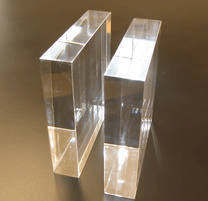In most cases business owners have many options when it comes to choosing a bullet resistant plastic. Most robberies in retail and bank settings are committed using handguns, and there are a variety of transparent ballistic plastics which can ably stop these smaller-caliber bullets. This gives business owners, architects, and designers latitude to focus on creating pleasant environments for workers, customers, guests, and staff.
TRADITIONAL BULLET RESISTANT PLASTICS
Traditionally, “bullet proof glass” has been dominated by either monolithic acrylic or laminated polycarbonate. Although both plastics stop bullets, each does so in a very different fashion, and has a very different impact on the overall feel of an interior.
Most bullet proof installations rely heavily on hard, inch-thick acrylic. Skilled craftsman can cut, route, drill, and polish this material to fit any space and blend with any decor. When a bullet strikes acrylic, it pancakes against the hard face of the plastic, and transfers an enormous amount of force to the acrylic. Instead of breaking, the acrylic absorbs this force by cracking across its surface in a dense spider web, and throwing off many small chips and shards (called “spall”). This looks ugly–and those flying shards could hurt someone–but the action saps the bullet of its driving force, and keeps everyone behind the bullet proof glass safe.
Polycarbonate, on the other hand, is a more pliable bullet resistant plastic. It’s manufactured in thinner sheets (usually 1/4 to 1/2-inch thick), which are built up into thicker layers in an industrial lamination process. Polycarbonate barriers can offer comparable bullet-resistance to acrylic at almost half the thickness and weight. When a bullet strikes the face of a polycarbonate barrier, it pushes in, like a finger into Jell-o. The dense, pliable polycarbonate sucks the bullet in, locking it up inside the layered plastic. This combination of durability and pliability means that a polycarbonate window can endure an obscene amount of physical battery–either from assailants or the elements. Subsequently, polycarbonate carries a forced-entry rating, which acrylic–despite its strength–does not.
But each of these materials has its downsides: the acrylic’s tendency to spall is obviously dangerous, and its lack of forced-entry durability makes it unsuitable to some settings. Meanwhile the polycarbonate, owing to its density, doesn’t transmit light very well. While acrylic absorbs less than 10 percent of the light that strikes it–ideal for bright, business-like lobbies and transaction areas–polycarbonate absorbs more than 20 percent of the light passing through it, and tends to make interiors seem a little dim.
LP1250BR: THE BEST OF BOTH BULLET RESISTANT PLASTICS
Total Security Solutions vice president Jim Richards has found that offering a bullet resistant plastic that combines the qualities of acrylic and polycarbonate is a perfect fit for many of his clients. This product is LP1250BR: a one-inch acrylic core with 1/8-inch polycarbonate end caps on either side. With LP1250BR, designers get the excellent light-transmission inherent to acrylic, without having to worry about spalling. Additionally, although LP1250BR does not carry a forced-entry rating, professionals in the field agree that the polycarbonate caps laminated to either side of the monolithic acrylic give LP1250BR windows a forced-entry boost.
KEEPING PRIORITIES
More so than other players in the field, Total Security Solutions is dedicated to aesthetics. Nonetheless, Jim occasionally finds people falling a bit too much in love with how a sheet of acrylic or polycarbonate looks after its been shot. Certainly, it’s impressive to see that sheet of polycarbonate with a bullet caught in it like a fly in amber, or to marvel at the flurry of cracks and shards that totally obscure a sheet of monolithic acrylic, yet still stop the bullet–but these really are details. “Sure, it looks great after its been shot,” he shrugs, “but if the acrylic stops it and the polycarbonate stops it, you’re going to have to replace it either way; who cares how it looks?” What counts is its day-to-day performance, choosing a material that balances daily needs with worst-case-scenario security.
NEXT STEPS:
- Contact us if you have any questions or are ready to get started on your next project
- Sign up for our newsletter to stay up-to-date with the latest industry news



